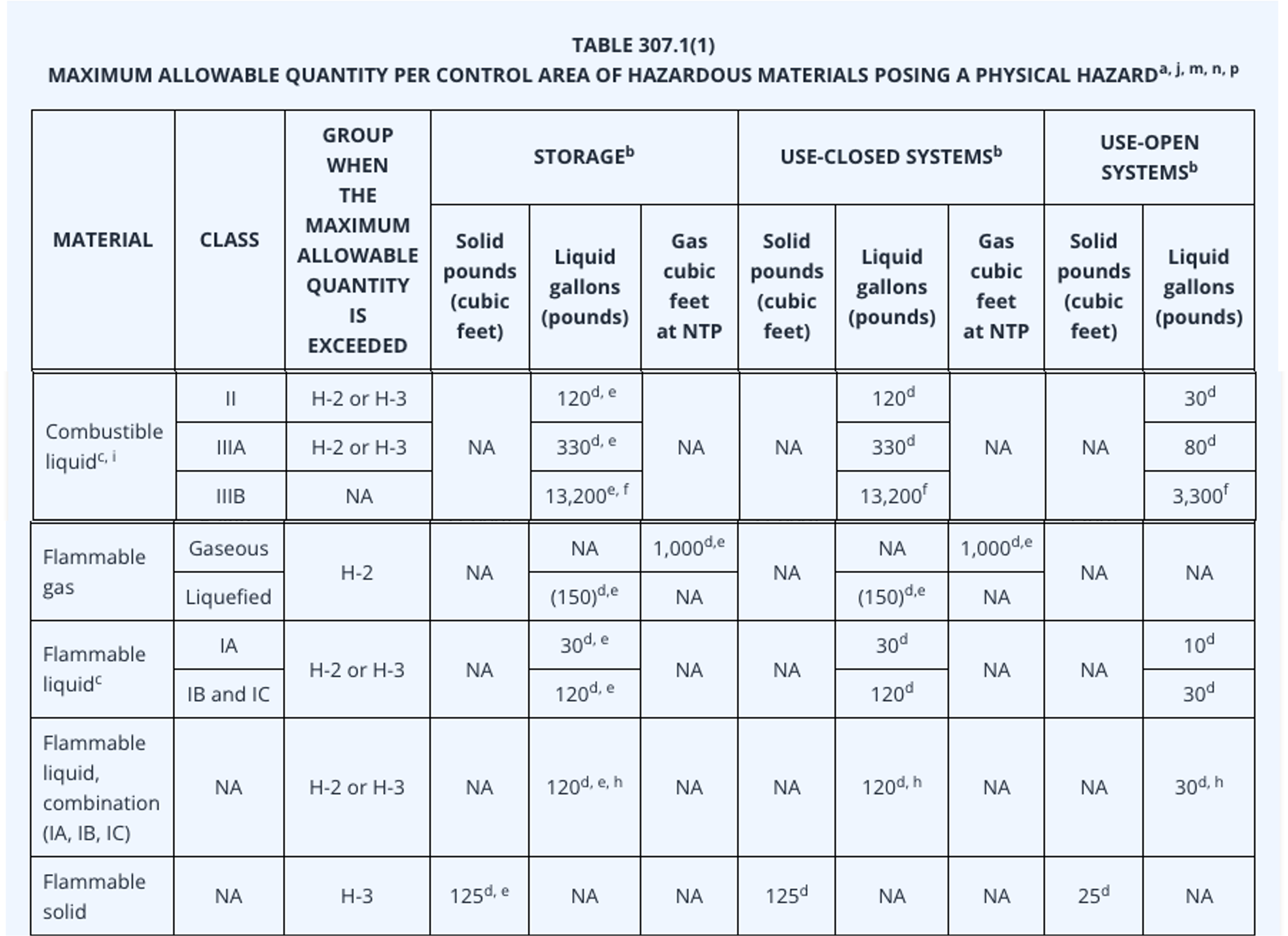Maximum allowable quantities (MAQs) are the maximum amount of hazardous materials allowed to be stored or used within a control area in a building. These limits are established by the California Building Code (CBC) or California Fire Code (CFC) and are broken down by hazard category.

MAQs
The MAQs are intended to ensure the quantities of hazardous materials in a building are within the safe operating levels for the fire and life safety elements to which the building is designed and operated. Adhering to these limits is essential for ensuring a building is safe for its occupants and first responders.
- Current baseline MAQ Levels in the California Building Code (Table 307.1)
- MAQ levels increase if the entire building is sprinklered
- MAQ levels decrease for storage above or below the ground-level floor
Frequently Asked Questions
A control area is a space within a building where hazardous materials are stored, dispensed, used or handled. Control areas are constructed with features like fire rated walls that prevent the spread of fire to and from other areas in the building, allowing for safe emergency egress and fire department response. The number of control areas on a floor of a building can vary, currently ranging from one to four on a floor.
Determining MAQs is complex and relies on several structural and operational factors.
The most common factors that determine MAQs at SFSU are:
► on which floor your lab is located (see Table 414.2.2 below FAQ)
► whether a fire sprinkler system is installed throughout the building
► use of approved storage cabinets
As emergency response and egress become increasingly difficult with building height, the quantity of hazardous materials that can be safely used and stored decreases. For example, the MAQs on floors 7th and above are 5% of those allowed on the 1st floor. However, if the entire building is equipped with a sprinkler system and approved storage cabinets are used, the MAQs on a specific floor can be increased from these values.
The CA Office of the Fire Marshal requires each room with a chemical inventory to post* the maximum allowable chemical storage by hazard class as determined by your department and EH&S. This amount is some percentage of the MAQ in the control zone the rooms are located in. This percentage may vary depending on the needs of the lab groups in a particular control area, as long as the control area MAQ is not exceeded.
Contact your department stockroom to get your approximate share of the MAQ for each hazard category. You can then check your inventory against these limits.
EH&S will periodically check how close a hazard category is to its MAQ for a particular control zone using the RSS Chemicals MAQ app.
The image below shows an excerpt of the RSS CHEMICALS MAQ table for one of the third floor control zones of the new science building (SEIC-3A). The image shows just the first two rows of the table. As of Feb. 12, 2024, there is no chemical storage in that control area yet so under Actual, the table shows 0.
*This MAQ posting is required in the new Science, Engineering Innovation Center (SEIC) building.

Find MAQ Status in RSS Chemicals
- Log into RSS and select the CHEMICALS app.
- Select the Inventory Summary button.
- Scroll down to the bottom right to find the MAQ Status.
Note: The MAQ Status you see is for the entire control area, not just your part of it. It will tell you if MAQs of any hazard category are being exceeded in the control area.
The video below illustrates these steps. (There is no narration.)
MAQs are set by the Fire Code to keep building occupants and first responders safe. Exceeding MAQs puts everyone at risk and is considered a serious offense. If your control area exceeds the MAQ, you will first receive an email notification with recommended corrective action. If the corrective actions cannot resolve the MAQ exceedance, EH&S will work with you and others in your area to develop a corrective action plan. Here are some common corrective actions available:
- decreasing the quantities of hazardous materials that you use and store,
- replacing old storage cabinets with approved cabinets,
- and in the most extreme cases, relocating research activities to another location.
Please note: Persuant to the Office of the State Fire Marshal (OSFM), a MAQ exceedance within a control area will prevent order approvals for ANY hazardous chemicals in that specific control area, not just those in the exceeded hazard class. For example, if the pyrophoric MAQ is exceeded in a control area, flammable, corrosive, or oxidizer chemical orders cannot be approved for that control area.
You can see which chemicals in your inventory belong to a specific hazard class by going to the RSS CHEMICALS module and select Search Chemicals on your inventory page.
Select the MAQ hazard class in the "Classification" field drop down list. If you are searching only for liquids, for example, then choose "liquid" in the "Physical State" field. The search will automatically update after these selections are made.
Note that some MAQ categories (such as Oxidizers and Flammable Liquids) are split further into additional classes.
1. In CHEMICALS, select the "Search Chemicals" button.
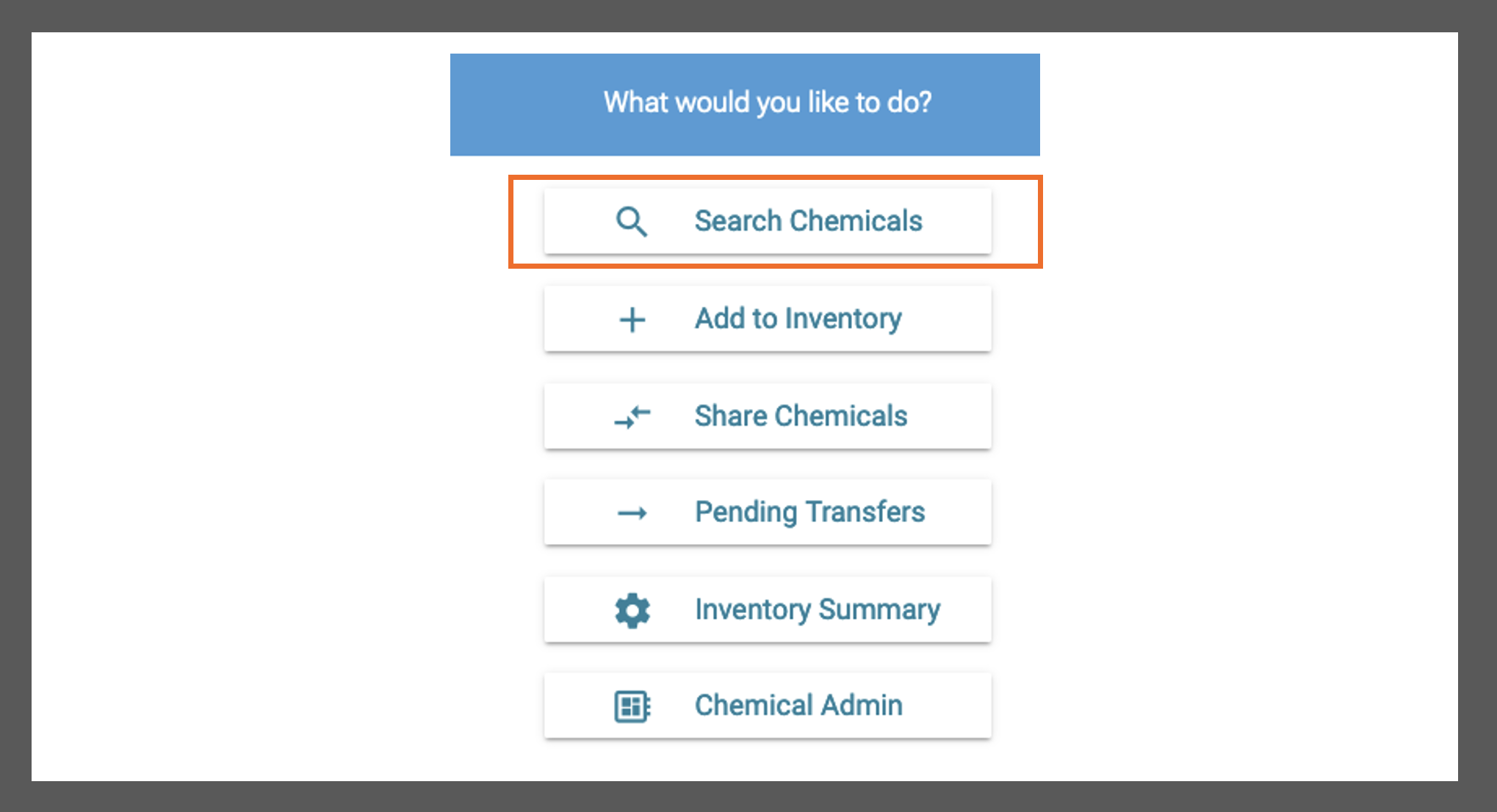
2. Select "Advanced Search", which is the small arrow on the right.
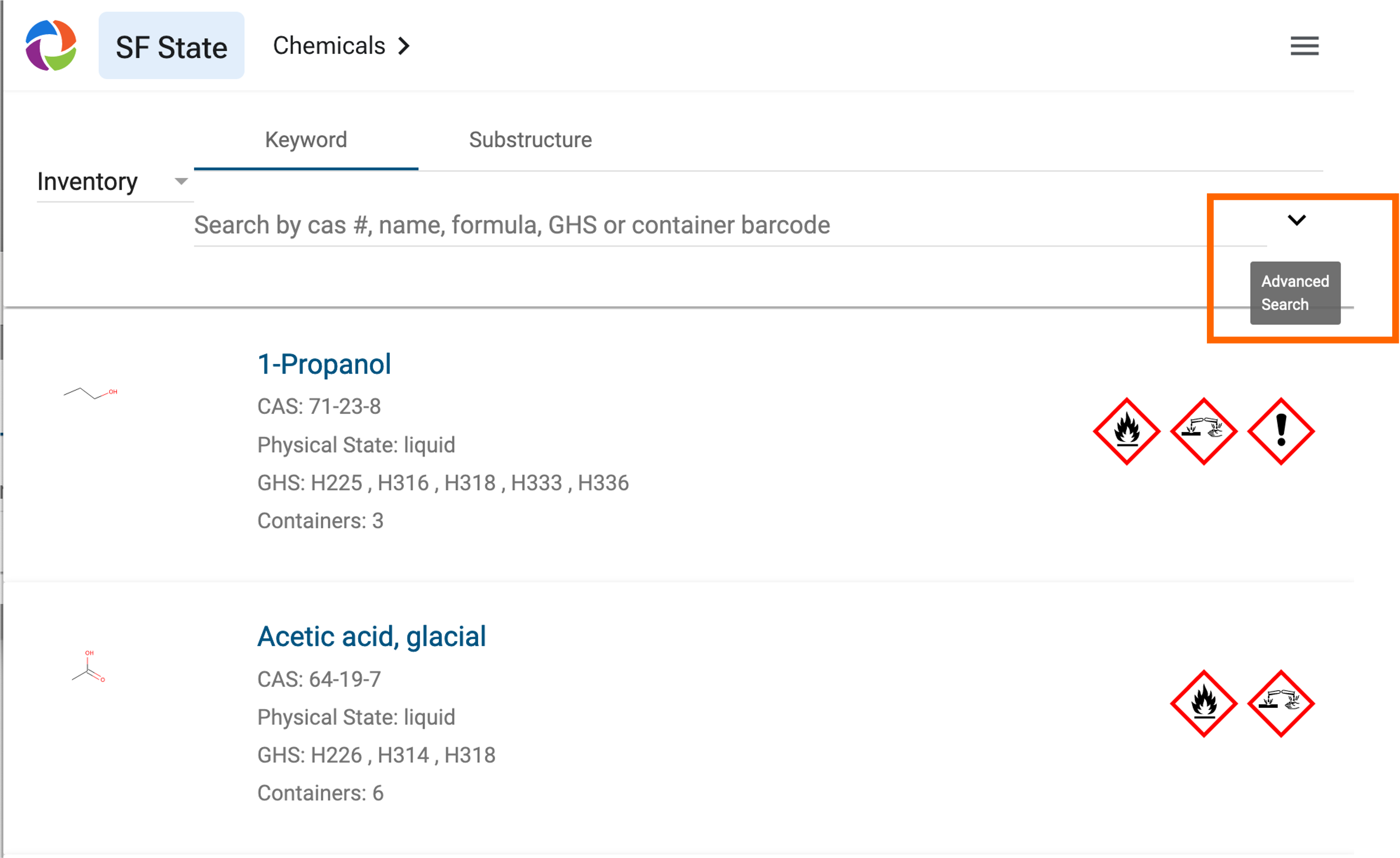
3. Select the "Classification" drop down menu with a list of hazard classes. Select the desired hazard class.

4. Once the classification is selected the search will automatically update and show the chemicals you have in this category.
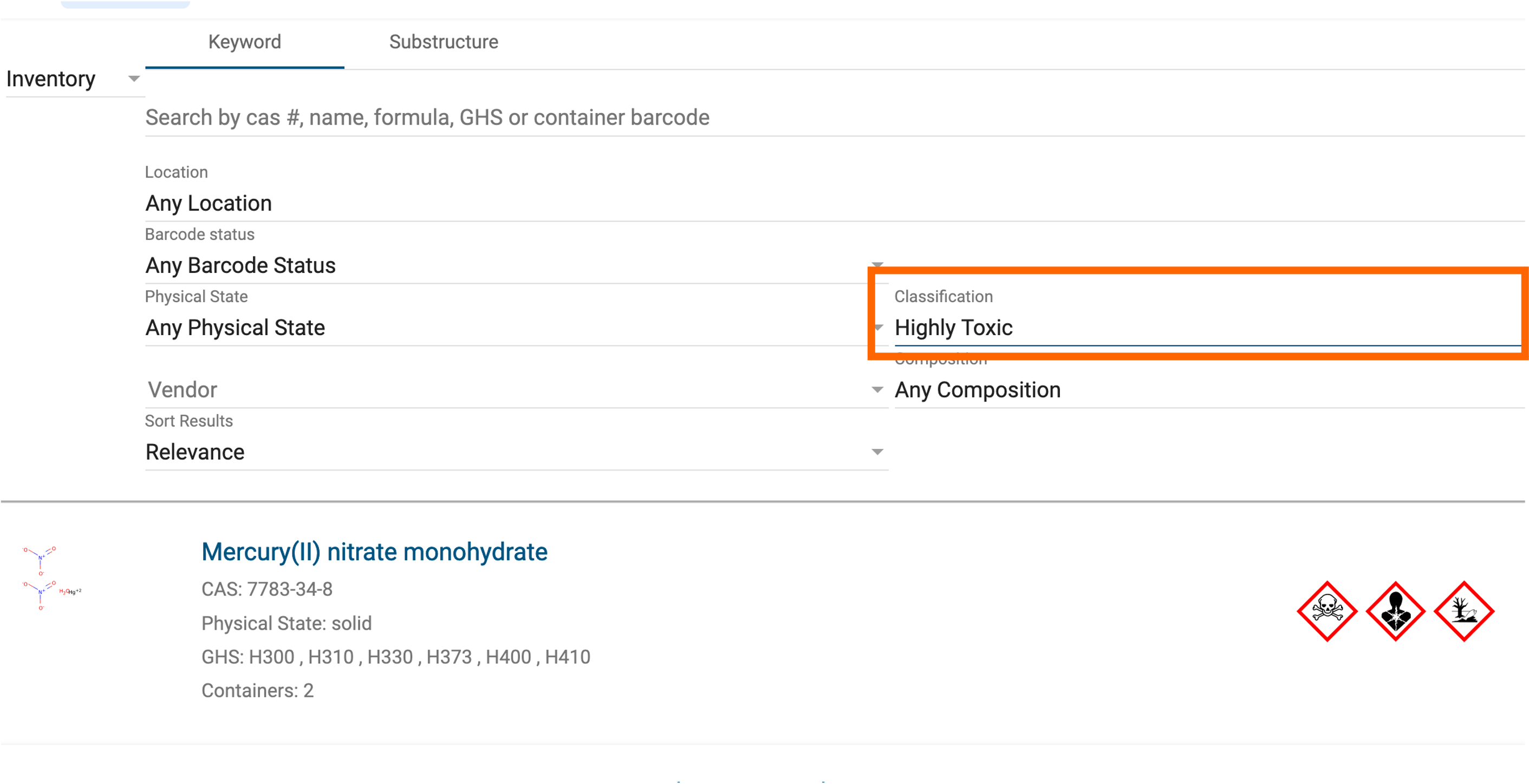
- Purchase smaller quantities of chemicals (i.e 500g instead of 1kg)
- Avoid purchasing duplicate chemicals and cases
- If possible, share chemicals (click here) to see how to borrow and share a container using RSS Chemicals
- Confirm that your chemical inventory is accurate
- Dispose of any expired or unneeded chemicals and update your inventory accordingly
MAQs are based on Control Areas. Contact your department for assistance in allocating allowed quantities for labs located in the same Control Area.
Reapportionment
Each lab group is allocated a share of the MAQs within a Control Area. If other lab groups in your Control Area don't need all of their allocation in a particular hazard class, you may negotiate with them to reduce their assigned allocation and transfer them to your lab. This is similar to trading carbon or emission credits. Note that the MAQs for the Control Area are not being exceeded. The allowed quantities within it are just being reapportioned.
Your department and EH&S need to approve the results of such negotiations.
Since MAQs are largely determined by building construction it can be very costly to increase the limit. Due to their complexity, MAQ increases must be addressed on a case-by-case basis. Please contact EH&S for assistance.
The California Building/Fire Codes that address Maximum Allowable Quantities were not in place when the three existing science buildings at SFSU were designed and built. To some extent, the buildings were "grandfathered" in. For example, current codes would not allow chemistry labs on the 8th floor of a Class B building.
The modern MAQs will be enforced after renovations. Hensill Hall had to meet current codes after the extensive earthquake renovations were completed in the mid-2000s.
Design and construction of the new Science Building, Science and Engineering Innovation Center (SEIC), has to meet current building and fire codes. The SEIC is primarily a Class B occupancy, not a Class L (Laboratory) or Class H (High Hazard). To get approval to occupy the building, the Office of the State Fire Marshal, requires the occupants to adhere to the MAQs for their Control Area. As part of this approval, SFSU has to provide the method by which we will track compliance.
Approved storage of hazardous materials is a space or cabinet that has been designed, engineered, and manufactured to reduce the health and physical hazards of these materials and that meet applicable standards.The CA Office of the Fire Marshal and the California Fire Code will determine what is "approved" storage.
Chemicals that are stored in approved storage cabinets, day boxes, gas cabinets, gas rooms, exhausted enclosures or in listed safety cans may increase MAQs for certain hazard categories.
For the purpose of increasing MAQs, "approved" storage mainly applies to flammables at SFSU. There are no "approved" corrosives cabinets that have an effect on MAQs, for example.
Contact EH&S if you have questions about whether your storage space, cabinet, or equipment is considered "approved" for the purposes of increasing allowable chemical storage limits.
Approved Flammables Storage Cabinet
Approved cabinets are designed to protect the internal contents from a fire outside the cabinet. Flammables storage cabinets that can be designated as "approved storage" must meet the following criteria:
- Cal/OSHA 8 CCR 5533 - Design, Construction and Capacity of Storage Cabinets
- NPFA 30
- Self-closing doors per California Fire Code (or International Fire Code, IFC)
- Underwriters Laboratory (UL) listed
Listed Safety Cans for Flammable or Combustible Liquids
The basic purpose of a safety can is the control of flammable vapors, while providing a convenient means of carrying, dispensing, and storing up to five gallons of flammable liquid.
NFPA Code 30 1.6.40 and OSHA 1910.106(a)(29) define a safety can as, "A listed (approved) container, of not more than 5-gal (18.9-L) capacity, having a spring-closing lid and spout cover and so designed that it will safely relieve internal pressure when subjected to fire exposure."
- NFPA 30
- OSHA 1910.106(a)(29)
- Underwriters Laboratory (UL) listed
Percent Maximum Allowable Quantities by Building Floor
This table shows the percentages of the maximum allowable quantities per control area shown in Tables 307.1(1) and 307.1(2), with all increases allowed in the notes to those tables.
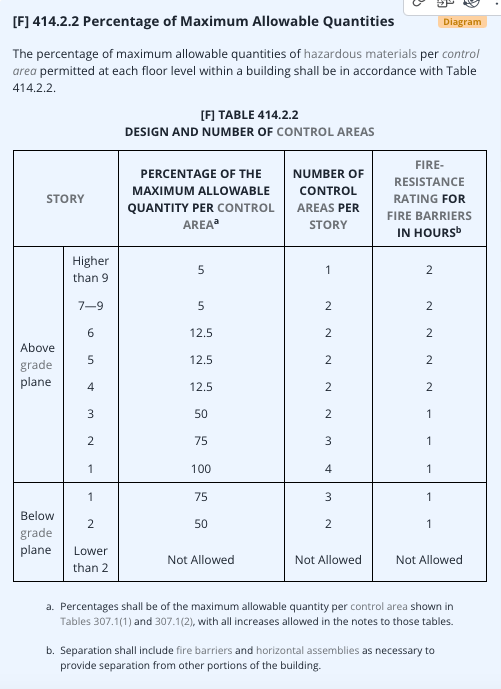
Maximum Allowable Quantities
Chapter 3, section 307.1 of the CA Fire Code includes tables of maximum allowable quantities per control area of hazardous materials posing physical hazards and health hazards.
Applicable Notes to Tables 307.1(1) and 307.1(2)
Note d. ... maximum allowable quantities shall be increased 100 percent in buildings equipped throughout with an automatic sprinkler system... Where Note e also applies, the increase for both notes shall be applied accumulatively.
Note e. Maximum allowable quantities shall be increased 100 percent when stored in approved storage cabinets, day boxes, gas cabinets, gas rooms or exhausted enclosures or in listed safety cans... Where Note d also applies, the increase for both notes shall be applied accumulatively.
Note h. Containing not more than the maximum allowable quantity per control area of Class IA, IB or IC flammable liquids.
Excerpt from Table 307.1(1), Maximum Allowable Quantity per Control Area of Hazardous Materials Posing a Physical Hazard.
